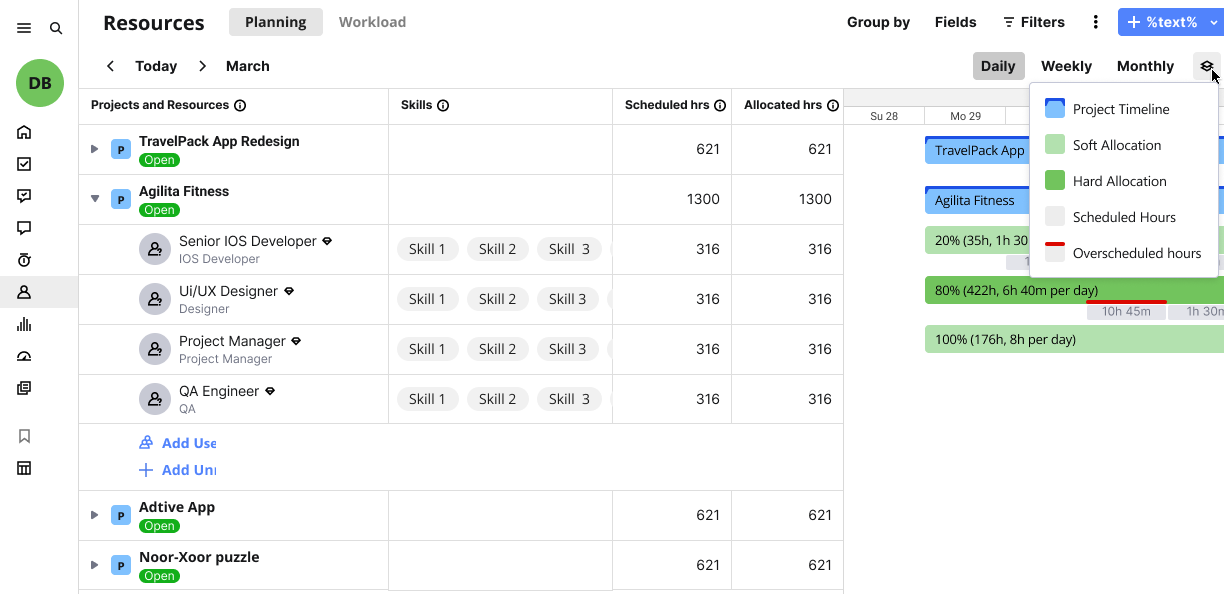What is resource allocation?
Resource allocation is a process of assigning resources to different tasks, projects, or activities based on their importance, priority, and availability.
By allocating resources effectively, organizations can ensure that they are maximizing their productivity by using their resources in the most productive way possible, leading to greater efficiency and profitability.
Effective resource allocation is also crucial for meeting project goals and deadlines. By ensuring that the right resources are available at the right time, organizations can ensure that projects are completed on time, on budget, and to the required quality standards.

Resource allocation can help organizations to manage costs more effectively by ensuring that resources are allocated based on their value and importance to the project or organization. This can help to prevent wasteful spending and ensure that resources are being used in the most cost-effective way possible.
Optimizing resource utilization: Effective resource allocation ensures that resources are utilized optimally, avoiding underutilization or overutilization. By allocating resources according to project requirements and priorities, organizations can achieve a balanced workload distribution and prevent resource bottlenecks. This leads to increased efficiency, reduced idle time, and improved overall resource productivity.
Managing risk: Effective resource allocation can help organizations to manage risk more effectively by ensuring that resources are allocated in a way that mitigates potential risks and uncertainties. For example, by allocating resources to multiple projects or activities, organizations can reduce the risk of delays or disruptions caused by unexpected events.
Enhancing adaptability and flexibility: Effective resource allocation enables organizations to adapt and respond to changing project needs or unforeseen circumstances. By having a well-planned allocation strategy, organizations can quickly reallocate resources when priorities shift, or new project demands arise. This flexibility allows for better resource optimization and the ability to seize opportunities or address unexpected challenges, enhancing organizational agility and responsiveness.
Improving team morale: Effective resource allocation can also help to improve team morale by ensuring that team members are working on projects that are meaningful and aligned with their skills and interests. This can help to increase job satisfaction and reduce turnover, leading to greater stability and continuity for the organization.
Improving collaboration and synergy: Effective resource allocation promotes collaboration and synergy among team members. By strategically assigning resources, organizations can create cross-functional teams, foster knowledge sharing, and encourage interdisciplinary collaboration. This not only enhances the quality of project outcomes but also boosts team morale and creates a positive work environment where diverse skills and expertise can be leveraged.
Overall, resource allocation is a critical component of effective project management and organizational success. By allocating resources effectively, organizations can ensure that they are using their resources in the most productive, efficient, and strategic way possible.
Resource allocation methods
Soft Allocation
Soft allocations serve as temporary reservations made by project managers to express their intent to work with specific resources. These allocations enable project managers to secure resource availability without fully utilizing the resource’s capacity. They offer flexibility as resources can still be allocated to other projects until a final decision is made by the resource manager. Soft allocations are suitable when project managers need to request resources or demonstrate resource needs for planning purposes.
Typically resource allocation happens before a project starts, for example when a sales team is negotiating a contract with a client, the resource manager can preliminarily allocate resources (sometimes referred to as “Soft” allocation”) to indicate that these specific resources might not be available to work on other projects.
Soft allocation can be done for specific people or positions (job roles), e.g. we will need a senior engineer for this project from May until December.
Hard Allocation
Hard allocations are definitive reservations established by resource managers. When a hard allocation is made, the resource’s capacity is fully utilized, and they are fully committed to the project. Hard allocations provide certainty and ensure that the allocated resources are dedicated exclusively to a specific project. They are beneficial when resource managers need to assign and reserve resources firmly for projects.
When the contract is won, the resource manager can change “soft” allocation to “hard” allocation, meaning that the booking for these people is now confirmed and finalized.
Resource allocation is specified in either absolute number (hours) or percentage of the time, e.g 50%.

Bottom-to-Top Approach
There are radically different approaches to Resource Allocation.
The method, when a project manager first creates the project work breakdown structure, identifies all tasks, their duration, timelines, and then creates resource allocations based on these tasks, is usually referred to as the “Bottom-to-Top” resource allocation approach.
This is typical for situations when a project is standard and all its details are known upfront.
Top-to-Bottom Approach
The “Top-to-Bottom” approach is more commonly used when the project‘s scope is not well defined yet, and the project or resource manager only has a rough idea of what resources will be required. In this scenario, resource allocations are created first just to book the resources, and all respective tasks are created later.
Responsibility for resource allocation
The process of resource allocation typically falls within the purview of a Project Manager or a Resource Manager, depending on the organization’s structure and size.
Project Manager
In many cases, particularly in smaller organizations, the Project Manager is responsible for resource management. They decide which resources are required for a project, who should be assigned to what task, and when these resources will be needed. This is because the Project Manager has a clear understanding of the project’s objectives and the tasks necessary to achieve these objectives.
Resource Manager
In larger organizations, there may be a dedicated Resource Manager or a resource management team. This role specifically focuses on understanding the organization’s overall resource capacity, competencies, availability, and allocation across all projects. The Resource Manager collaborates closely with Project Managers to ensure that resources are utilized efficiently and distributed effectively across various projects.
The primary reason behind this allocation of responsibility is that these roles possess a comprehensive understanding of the project’s needs and available resources. They are able to balance the demand (project requirements) with the supply (available resources) efficiently. Their expertise ensures that resources are not over or under-utilized, promoting maximum productivity and project success.
By aligning the right resources to the right tasks at the right time, those responsible for resource allocation play a critical role in ensuring that projects are completed on time, within budget, and to the necessary quality standard. They also ensure that the organization is making the most efficient use of its resources, thereby improving overall performance and competitiveness.
Resource allocation process
Here is what a typical resource allocation process can look like in an engineering company:
- Identify resource requirements:
The engineering firm starts by identifying the specific resources needed to deliver services to clients. This includes identifying the roles and expertise required, such as project managers, engineers, architects, software developers, and any specialized equipment, software licenses, or materials necessary for project execution. Clear identification of resource requirements helps in planning and allocating resources accurately. - Assess available resources:
The next step is to assess the availability of resources within its pool. This involves reviewing staffing levels to determine the number of available personnel and their skills. It also includes evaluating equipment availability, such as machinery, tools, or specialized hardware and software required for project tasks. Additionally, inventory levels are assessed to ensure the availability of materials needed for the projects. - Prioritize resource allocation: Once the resource requirements and availability have been assessed, the organization needs to prioritize the allocation of resources. This involves considering various factors such as project deadlines, budget constraints, strategic importance, and client requirements. Projects with critical deadlines or high-budget allocations may receive higher priority for resource allocation, while projects with longer timelines or lower budgets may be assigned lower priority.
- Allocate resources: Based on the prioritization, resources are allocated to specific projects or tasks. This step involves matching the identified resource requirements with the available resources. Specific engineers or job roles are assigned to projects based on their expertise and compatibility with project needs. Equipment, such as machinery or software licenses, are assigned to support specific service lines or project requirements. Materials needed for project tasks are ensured to be available to facilitate smooth execution.
- Adjust resource allocation as needed: Finally, if it becomes apparent that adjustments are required, the organization must be flexible and prepared to make necessary changes. This may involve re-assigning personnel to different projects or tasks to better align their skills or addressing any resource gaps that may arise. Acquiring additional equipment or materials may be necessary to meet unforeseen demands. Regular evaluation of resource allocation allows for adjustments and optimizations to ensure the successful completion of projects.
Common mistakes in resource allocation by new resource managers
While resource allocation is a critical aspect of managing projects, it is also a complex process that requires experience and skill. Below are some common errors that a young or inexperienced resource manager might make:
- Poor Understanding of Resources
One of the main mistakes is not fully understanding the skills, capabilities, and capacities of each team member. This could lead to misallocation, overworking, or underutilizing of resources. - Overallocation of Resources
This is when a resource manager assigns more tasks to an individual or team than they can handle, resulting in burnout, decreased productivity, and poor-quality work. - Underallocation of Resources
On the opposite end, underallocating resources mean some team members may not have enough work, leading to inefficient use of resources. - Failure to Prioritize
A common mistake is not properly prioritizing tasks. This could lead to focusing on less critical tasks while more important ones are neglected. - Lack of Flexibility
Resource allocation is not a one-time process. It requires constant review and adjustments as the project progresses. Failing to adjust resource allocation in response to changes can harm the project’s progress. - Inadequate Communication
Poor communication about roles, responsibilities, and expectations can lead to confusion, errors, and delays. - Ignoring Human Factors
Resource managers must remember that their resources are human. Ignoring aspects such as vacation time, personal needs, and work-life balance can negatively affect morale and productivity. - Failing to Use Resource Management Tools
Modern project management involves a variety of tools designed to make resource management easier. Ignoring these tools can make the resource allocation process more challenging than it needs to be.
Understanding these common pitfalls can help a young resource manager avoid them, leading to more effective and successful resource allocation and project management.